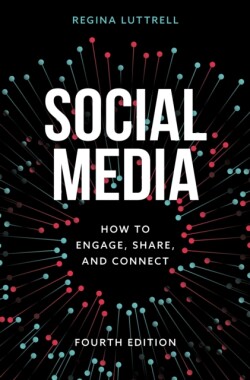THIRD EDITION DESCRIPTION
Updated to reflect the latest technological innovations—and challenges—Social Media: How to Engage, Share, and Connect helps students understand and successfully use today’s social media tools.
Luttrell’s text offers:
– a thorough history of social media and pioneers of the field;
– chapters on specific subjects such as photo-sharing, video, crisis communication, ethics, and “sticky social,” among others;
– discussions on appropriate use of social media in public relations, where the profession stands today and where it is headed in the future; and
– real-world examples of successful social media campaigns.
This book will become your go-to reference guide for all things social media-related as it applies to public relations and the everyday duties of PR professionals
AUTHOR'S REVISION PLAN
In addition to updating some of the links and refreshing the case studies throughout, this document contains specific updates that are necessary to keep Social Media: How to Engage, Share, & Connect current and relevant in the marketplace.
Global Changes:
- Updates to statistics and numbers throughout the book.
- Updates to in-text examples of brands using social media.
- Updates to all case studies.
Chapter 4: The Roadmap to Success: Developing a Social Media Plan
- Diversity First Approach:
- A 21st century look at the United States reveals that we are more ethnically and racially diverse than we have been historically, yet we continue to see gaffes in public relations campaigns that are simply unacceptable.
- These examples are all discussed in Chapter 12 Crisis Communication: Dove Beauty, Kent State, Gucci, Pepsi Co. and H&M are a few companies that have dealt with high-level embarrassing crisis situations due to incomprehensible social media and PR campaigns.
- I’d like to add content surrounding the ‘diversity first’ approach. In doing so, from the initial stages of research through evaluation we can teach our students how to develop more inclusive campaigns. Making diversity and inclusion top of mind when developing social media strategies for is needed in this next edition.
Chapter 7: Social Networks
This chapter highlights the major social networking sites including Facebook, Twitter, LinkedIn, Snapchat, and Pinterest. In addition to updating the chapter with new statistics for the platforms currently listed, the addition of TikTok is necessary.
- TikTok:
- TikTok used in PR
- With 500 million monthly users TikTok surpassed Facebook, Instagram, Snapchat and YouTube in monthly downloads in the U.S. this year. Brands are starting to use for PR and marketing efforts. The first two companies to adopt a strategy were Guess and Universal Pictures. Both campaigns were extremely successful. The book needs to be updated to include this platform because it is the next SM tool used in our profession. Students must understand how to employ a strategy around TikTok. It is only a matter of time before the app introduces advertising and formal influencer marketing programs like other platforms.
Chapter 10: Measuring Social Media’s Impact & Value
- Data in PR
- In its current form this chapter addresses the fundamentals of measurement. We are in a new age where the consumer is in control. An unprecedented growth rate of social media adoption, where every interaction creates “big data” that can be tracked, mined and analyzed to inform strategic decisions. Those who understand how to harness the power of advanced analytics, social media analytics, social media listening and then apply data driven insights to precision targeting, engagement planning and content optimization, will reap the benefits and capture market opportunity.
- To this chapter, I want to add the importance of data driven decisions in the profession. Everything we share on social media is in the public domain. This creates a massive opportunity to glean intelligence down to the level of an individual, giving way to the endless possibilities on how measure and target individuals based on their personality traits, habits, preferences, relationships and even political views … all from their digital footprints.
- Artificial Intelligence (AI), NLP, and data will be included. The content here will support the changes suggested in chapter 11.
Chapter 11: Social Media Ethics
- Ethics of SM:
- Because of its transformative capacity across multiple domains, artificial intelligence (AI) is considered a textbook case in industry disruption. Algorithm-powered machines are taking on tasks faster and with fewer errors than those once completed by humans. This illustrates that AI has gained both momentum and importance within society over the past few years – and within PR and social media. AI can complement a communication professionals’ skills such as predicting trends of publics, monitoring social media conversations, detecting fake news stories in an effective manner, speech recognition, decision-making, visual enhancements, and historical data. With all of this though, we must contend with the ethical dilemmas AI and data bring to the profession.
- To that end, I’d like to add a section in the ethics chapter on the implications of AI, data, and privacy.

















